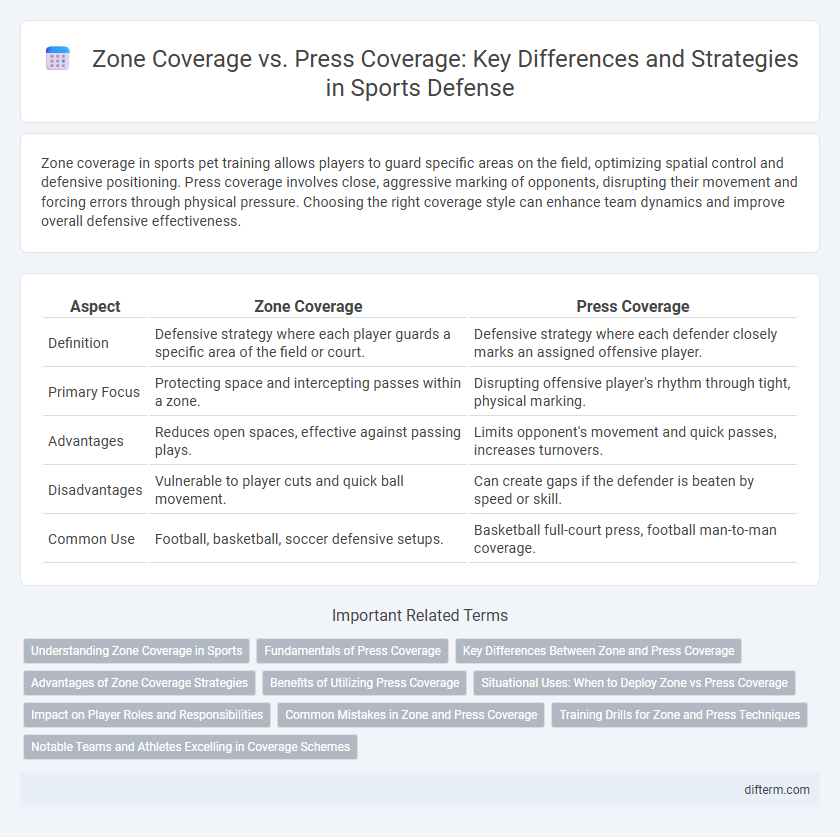Zone coverage in sports pet training allows players to guard specific areas on the field, optimizing spatial control and defensive positioning. Press coverage involves close, aggressive marking of opponents, disrupting their movement and forcing errors through physical pressure. Choosing the right coverage style can enhance team dynamics and improve overall defensive effectiveness.
Table of Comparison
| Aspect | Zone Coverage | Press Coverage |
|---|---|---|
| Definition | Defensive strategy where each player guards a specific area of the field or court. | Defensive strategy where each defender closely marks an assigned offensive player. |
| Primary Focus | Protecting space and intercepting passes within a zone. | Disrupting offensive player's rhythm through tight, physical marking. |
| Advantages | Reduces open spaces, effective against passing plays. | Limits opponent's movement and quick passes, increases turnovers. |
| Disadvantages | Vulnerable to player cuts and quick ball movement. | Can create gaps if the defender is beaten by speed or skill. |
| Common Use | Football, basketball, soccer defensive setups. | Basketball full-court press, football man-to-man coverage. |
Understanding Zone Coverage in Sports
Zone coverage in sports, particularly in football, involves defenders guarding specific areas of the field rather than marking individual opponents. This strategy emphasizes spatial awareness and teamwork to anticipate offensive plays and limit passing options. Effective zone coverage relies on communication and disciplined positioning to disrupt the opposing team's rhythm and reduce big-play opportunities.
Fundamentals of Press Coverage
Press coverage in sports defense demands intense physicality and precise communication to disrupt the opponent's playmaking abilities. Players are required to maintain close, man-to-man pressure, often employing aggressive hand-fighting techniques and rapid adjustments to the receiver's movements. Mastering the fundamentals such as positioning, anticipation, and timely interceptions is essential for effective press coverage that stifles offensive rhythm.
Key Differences Between Zone and Press Coverage
Zone coverage assigns defenders to specific field areas to guard any receiver entering their zones, emphasizing spatial control and reducing big-play opportunities. Press coverage involves defenders closely matching receivers at the line of scrimmage, disrupting routes early and increasing chances for turnovers through jams or batted passes. The key differences lie in the spatial assignment and physical engagement, with zone focusing on area defense and press relying on direct man-to-man confrontation.
Advantages of Zone Coverage Strategies
Zone coverage in football offers defensive advantages by allowing players to cover specific areas rather than individual opponents, enhancing team coordination and reducing mismatches. This strategy improves the defense's ability to react quickly to passing routes and limits big plays by maintaining coverage integrity across the field. Zone coverage also helps defenders conserve energy by minimizing constant man-to-man chases, contributing to sustained defensive pressure throughout the game.
Benefits of Utilizing Press Coverage
Press coverage in football enhances defensive pressure by disrupting receivers' routes early, forcing quick decisions and increasing the likelihood of turnovers. It allows defenders to closely monitor receivers, reducing separation and limiting passing options for the quarterback. This aggressive style of coverage is effective in controlling the pace of the game and can frustrate offenses by minimizing easy completions.
Situational Uses: When to Deploy Zone vs Press Coverage
Zone coverage excels in preventing deep passes and is ideal against teams with strong vertical passing attacks or mobile quarterbacks. Press coverage disrupts receivers' routes at the line of scrimmage, making it effective in short-yardage and third-down situations to force quick decisions. Defensive coordinators deploy zone coverage to protect vulnerable areas, while press coverage is used to apply immediate pressure and create turnovers.
Impact on Player Roles and Responsibilities
Zone coverage redefines defensive player roles by assigning specific field areas to monitor, emphasizing spatial awareness and rapid zone shifts to contain offensive advances. Press coverage demands aggressive man-to-man tactics, increasing cornerbacks' responsibilities in tight, physical confrontations to disrupt receivers' routes and timing. The contrasting coverage strategies shape skills development, with zone fostering strategic zone recognition and press emphasizing physicality and quick reactions.
Common Mistakes in Zone and Press Coverage
Common mistakes in zone coverage include defenders failing to communicate effectively, resulting in open passing lanes and missed assignments in their designated areas. In press coverage, players often commit the error of over-committing or biting on fakes, which allows receivers to break free and gain separation easily. Both coverage types suffer from poor positioning and lack of anticipation, leading to breakdowns and increased vulnerability to big plays.
Training Drills for Zone and Press Techniques
Effective training drills for zone coverage emphasize spatial awareness and communication, with players practicing drop-back zones and quick pass break-ups to intercept throws. Press coverage drills focus on pressuring receivers at the line of scrimmage through jam techniques, hand-fighting, and maintaining tight man-to-man positioning. Incorporating cone drills, reaction time exercises, and controlled scrimmages enhances defenders' agility and adaptability in both zone and press scenarios.
Notable Teams and Athletes Excelling in Coverage Schemes
The New England Patriots are renowned for their mastery of zone coverage, anchored by players like Stephon Gilmore, whose anticipation and spatial awareness disrupt passing lanes effectively. Conversely, the Chicago Bears have a rich history of excelling in press coverage, highlighted by legendary cornerbacks such as Charles Tillman, whose physicality and tight coverage skills excel at disrupting receivers at the line of scrimmage. These teams demonstrate how specialized defensive schemes, matched with elite athletes, can dominate opposing offenses through strategic coverage techniques.
Zone Coverage vs Press Coverage Infographic

 difterm.com
difterm.com